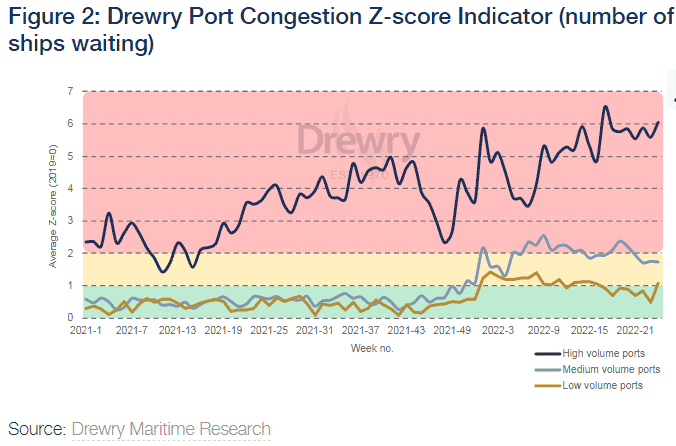Ocean container rates are at long last pulling back, but not so much to stop carriers from making outsized profits, and it will take some time return to a more normal rate environment, in continued bad news for global shippers.
Supply Chain Digest Says... |
 |
|
Drewry estimates the delays will reduce effective container ship capacity by about 15% below potential this year, following a 17% reduction in 2021. |
|
 |
|
What do you say? |
|
| Click here to send us your comments |
|
| |
|
| Click here to see reader feedback |
|
|
|
That are least is the opinion of the maritime analysts at Drewry Shipping, in their latest blog posting.
“The container market has definitely turned, but don’t expect a swift normalization,” Drewry notes.
The market feels like it is at the beginning of the end of the great container market bull run since shortly after the start of pandemic in 2020. Drewry adds.
For example, a slide in the spot rate market has become entrenched, rolling on for four months and with the dips getting bigger by the week. What’s more, container volumes along most trade routes are also down versus the same point a year ago, and likely to stay that way given continued high inflation.
That hasn’t stop container carriers from continuing to enjoy strong profits, posting record EBIT numbers in the first quarter of the year despite lower volumes. Q2 numbers will be out soon.
“We always knew that extreme freight rates were unsustainable, the only questions were; when the market would turn and then, how quickly?” Drewy say, adding it believes it will take still take some time.
One reason: Carriers still hold the ace card: of port congestion, Drewry observes, adding “Take that away and we would expect to see a very swift normalization of the market.”
As seen in the graphic below, at large global ports the number of ships waiting for a berth continues to rise:

What’s more, changing a previous prediction, Drewry doesn’t see conditions at the large ports easing meaningfully until 2023.
(See More Below)
|
CATEGORY SPONSOR: SOFTEON |
|
|
|
|
|
The congestion keeps rates high, Drewry notes, because that holds capacity that shippers otherwise would be able to access.
In fact, Drewry estimates the delays will reduce effective container ship capacity by about 15% below potential this year, following a 17% reduction in 2021.
Another wild card from high inflation is how it impacts labor, notably in potential demands from dock workers on West Coast ports in the negotiations currently in progress, which worst case could lead to a strike.
But Drewry does see global container volumes rising modestly this year, but just by 2.3%, down from a previous forecast of 4.1% growth- and it notes, with some risk to the downside.
“The end of the containers boom cycle will require a paradigm shift from all stakeholders,” Drewry concludes, adding that “Ocean carriers need to address the looming environmental and over-capacity risks by scrapping older, less green ships, while shippers might be wise to wait for the market to come back to them before committing to lengthy contracts.”
What are your thoughts Drewy's observations? Let us know your thoughts at the Feedback section below.
Your Comments/Feedback
|

